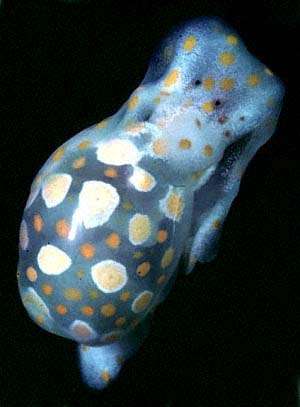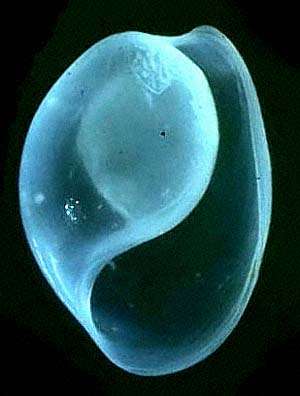

Haminoea sp. 3.
Order: CEPHALASPIDEA
Superfamily: HAMINOEOIDEA
Family: Haminoeidae
DISTRIBUTION
Tropical west Pacific?
PHOTO
UPPER: 9mm long; Northern Marianas, Tinian, Kammer Beach, reef flat; 26 May 1981.
LOWER: Shell (4.7 x 3.2mm) of above animal. PHOTOS: Clay Carlson.
Summary of characters:
Gizzard plates with ridges e.g. typical haminoeid forms -- H. cymbalum being atypical in this sense. Radula 7.1.7 with 3 large plate-like denticles on inner edge of 1st lateral (light scope); these do not show up with the SEM. Specimens from Guam, Rota, Tinian & Saipan.
Note from Clay Carlson & Patty Jo Hoff.
See their message below.
Compare with other orange-spotted species:
Haminoea cymbalum
Haminoea ovalis
Haminoea sp. 1.
Haminoea sp. 2.
Rudman, W.B., 1999 (July 1) Haminoea sp. 3. [In] Sea Slug Forum. Australian Museum, Sydney. Available from http://www.seaslugforum.net/find/hamisp3
Related messages
A fifth orange-spotted Haminoea
March 30, 1999
From: C.Carlson & PJ.Hoff
Bill,
Since I was writing I felt that the 5th of our orange spotted beasts might as well be included.
Here is the data for the photos: UPPER: 9mm; Northern Marianas, Tinian, Kammer Beach, reef flat; 26 May 1981. LOWER: 9mm living; shell 4.7 x 3.2mm (= above animal).
The gizzard plates have ridges e.g. typical haminoeid forms -- H. cymbalum being atypical in this sense. Radula 7.1.7 w/3 large plate-like denticles on inner edge of 1st lateral (light scope); these do no show up with the SEM. Specimens from Guam, Rota, Tinian & Saipan.
Concerning separating the orange-spotted species and which have purple marks, here is a summary of the characters we use to separate the 5 species.
Haminoea sp. 1.: Our code 'all orange spots'; we have no notes re purple on the animal. Orange spots on mantle of about the same size (propodia smaller), general scattered white flecking on mantle between spots. Spots do not appear with a white 'halo'. In one specimen the spots were more yellow than orange and were so thick on the foot margin that they appeared as a band rather than a series of spots. [Carlson & Hoff #c05: Lindsay Warren #78]
Haminoea sp. 2.: little purple, if any; relative size of orange spots smaller than those of C05; may have some spots connected by white as in H. cymbalum. Usually a pale green. [we found we don't have written description of this animal and have no idea if whether or not we kept the
12 that were measured. [Carlson & Hoff #c86: Lindsay Warren #79]
H. ovalis: the scan you have is full of purple --it just looks black. We have others with almost as many small purple spots on the mantle as there are orange spots. Earlier we commented on the 'juvenile red'
phenomena with Micromelo guamensis and Atys naucum. With H. ovalis it would be a 'juvenile purple.' I can try a scan but the juvenile slide is not in the best of shape.
Once we knew we had separate species & had some idea how to tell them apart, we have not spent too much time on the orange spotted forms. There is another that is full of fine orange spots, H. linda Marcus &
Burch, 1965. The specimen we have from Palau has a fairly dark green background so that the fine orange does not show up as well as it would on a lighter animal. The Palau specimen does have the additional lobe on
the left branch of the prostate as describe in the the original article. We do have a problem with the orange spotted beasts -- when we go after the female system invariably the anterior mucus gland goes off and messes up the system. We don't have this problem with sand dwelling forms.]
cheers,
Clay & Patty Jo
clay.carlson@kuentos.guam.net
Carlson, C. & Hoff, P.J., 1999 (Mar 30) A fifth orange-spotted Haminoea. [Message in] Sea Slug Forum. Australian Museum, Sydney. Available from http://www.seaslugforum.net/find/731Dear Clay & Patty Jo,
Thanks very much for this. I think Eveline Marcus sent me a copy slide of Haminoea linda many years ago. Again I had assumed it was a form of H. cymbalum. I'll look it out and if the slide is any good I'll post a copy and make it 6 orange-spotted species.
Best wishes,
Bill Rudman.
